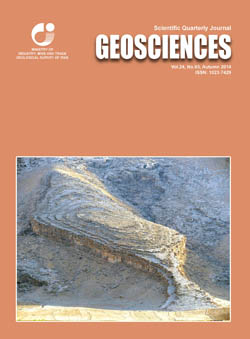Document Type : Original Research Paper
Authors
1 M.Sc., Department of Geology, Faculty of Sciences, Golestan University, Gorgan, Iran
2 Assistant Professor, Department of Geology, Faculty of Sciences, Golestan University, Gorgan, Iran
3 M.Sc., Exploration and Development Engineering Affairs, SarCheshmeh Copper Complex, National Iranian Copper Industries Co., Rafsanjan, Iran
Abstract
Present study is the first report of the rhenium and osmium isotopic data in the hypogene Cu-Fe sulfides (chalcopyrite and pyrite) from the Kerman porphyry copper deposits. Although data set was limited in this study, their interpretation helped to understand the possible sources of the metal for mineralization in the porphyry copper system. Based on this study, initial 187Os/188Os value in deposits recorded at least 0.1 to maximum 10 that the variation range for this ratio is much larger than the range detected in the Chilean porphyry copper deposit (from 0.15 to 5.2). The recorded non-radiogenic to radiogenic values for initial osmium ratio in primary sulfides of the Kerman porphyry copper deposits revealed isotopic heterogeneity and diversity in metal source for mineralization in these deposits. The record of the non-radiogenic values for initial 187Os/188Os (0.10- 0.15) in sulfides of the Miduk and Now Chun deposits, in the range of mantle values (0.13- 0.15), showed the main role of ore-forming fluids derived from mantle-derived magma (intrusive body) for supplying of the metal required for mineralization in these deposits. In contrast, too large deviation observed in initial 187Os/188Os values in sulfides of the Kerver (10) and Abdar (1) deposits respect to the mantle values showed the greater share of crustal sources (continental crust) rather than mantle sources in supplying of the metal for mineralization in these deposits. The Sar Cheshmeh deposit revealed less radiogenic value of initial osmium ratio in potassically sulfides (0.22) respect to phyllically sulfides (0.79), showing the contribution both the mantle and the crustal materials in supplying of the metal for mineralization, although the role of crust during the final stages of mineralization has been more important. The observed general trend in 187Os/188Os values being more radiogenic from old, high-grade deposits (middle Miocene) to young, low-grade deposits (upper Miocene- Pliocene) in the Kerman porphyry copper belt is attributed to increasing of the crustal sources contribution in generation of the young sub-productive-to-barren magmas and also in supplying of the metal for associated weak mineralization. This relationship can be suggested as a key for distinguishing and exploration of porphyry copper deposits with economic grades, the deposits that have been inherited greater share of the mantle source for generation of productive magma and also required metal for mineralization in porphyry system.
Keywords

